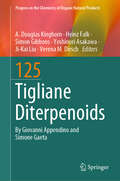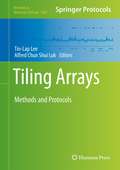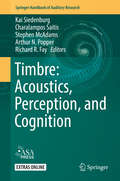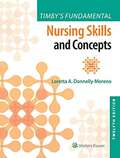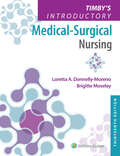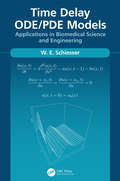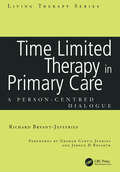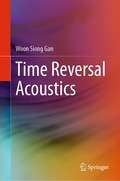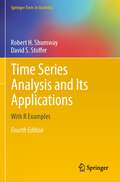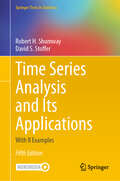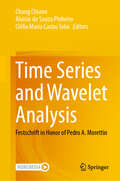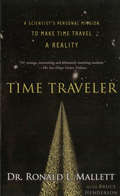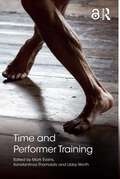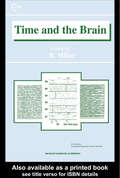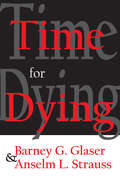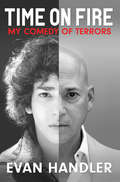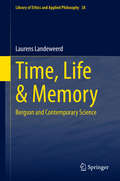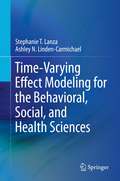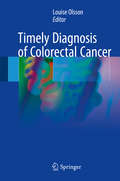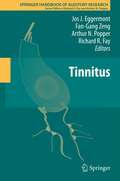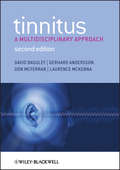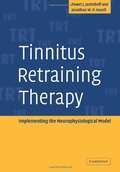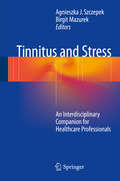- Table View
- List View
Tigliane Diterpenoids (Progress in the Chemistry of Organic Natural Products #125)
by A. Douglas Kinghorn Heinz Falk Simon Gibbons Yoshinori Asakawa Ji-Kai Liu Verena M. DirschThis book reviews the distribution, chemistry, and molecular bioactivity of tiglianes from the very beginning of the studies on these diterpenoids. It provides a summary of their clinical and toxicological literature mostly in its more recent and controversial aspects, while critically analyzing various proposals for their biosynthesis.
Tiling Arrays: Methods and Protocols
by Tin-Lap Lee Alfred Chun Shui LukIn Tiling Arrays: Methods and Protocols, expert researchers in the field detail many of the methods which are now commonly used to study tiling microarrays in genomic discovery . These include methods and applications for transcriptional regulation, expression, genetic and epigenetic regulation, as well as techniques and skills on tiling microarray data analysis. Written in the highly successful Methods in Molecular Biology series format, chapters include introductions to their respective topics, lists of the necessary materials and reagents, step-by-step, readily reproducible laboratory protocols, and key tips on troubleshooting and avoiding known pitfalls. Authoritative and practical, Tiling Arrays: Methods and Protocols seeks to provide scientists with a comprehensive and down to earth approach to maximize results.
Timbre: Acoustics, Perception, and Cognition (Springer Handbook of Auditory Research #69)
by Arthur N. Popper Richard R. Fay Stephen McAdams Charalampos Saitis Kai SiedenburgRoughly defined as any property other than pitch, duration, and loudness that allows two sounds to be distinguished, timbre is a foundational aspect of hearing. The remarkable ability of humans to recognize sound sources and events (e.g., glass breaking, a friend’s voice, a tone from a piano) stems primarily from a capacity to perceive and process differences in the timbre of sounds. Timbre raises many important issues in psychology and the cognitive sciences, musical acoustics, speech processing, medical engineering, and artificial intelligence. Current research on timbre perception unfolds along three main fronts: On the one hand, researchers explore the principal perceptual processes that orchestrate timbre processing, such as the structure of its perceptual representation, sound categorization and recognition, memory for timbre, and its ability to elicit rich semantic associations, as well as the underlying neural mechanisms. On the other hand, timbre is studied as part of specific scenarios, including the perception of the human voice, as a structuring force in music, as perceived with cochlear implants, and through its role in affecting sound quality and sound design. Finally, computational acoustic models are sought through prediction of psychophysical data, physiologically inspired representations, and audio analysis-synthesis techniques. Along these three scientific fronts, significant breakthroughs have been achieved during the last decade. This volume will be the first book dedicated to a comprehensive and authoritative presentation of timbre perception and cognition research and the acoustic modeling of timbre. The volume will serve as a natural complement to the SHAR volumes on the basic auditory parameters of Pitch edited by Plack, Oxenham, Popper, and Fay, and Loudness by Florentine, Popper, and Fay. Moreover, through the integration of complementary scientific methods ranging from signal processing to brain imaging, the book has the potential to leverage new interdisciplinary synergies in hearing science. For these reasons, the volume will be exceptionally valuable to various subfields of hearing science, including cognitive auditory neuroscience, psychoacoustics, music perception and cognition, but may even exert significant influence on fields such as musical acoustics, music information retrieval, and acoustic signal processing.It is expected that the volume will have broad appeal to psychologists, neuroscientists, and acousticians involved in research on auditory perception and cognition. Specifically, this book will have a strong impact on hearing researchers with interest in timbre and will serve as the key publication and up-to-date reference on timbre for graduate students, postdoctoral researchers, as well as established scholars.
Timby's Fundamental Nursing Skills And Concepts
by Loretta A. Donnelly-MorenoThe Twelfth Edition of Timby’s Fundamental Nursing Skills and Concepts continues the tradition of excellent coverage of basic nursing theory and clinical skills that have long made this text a leading resource for LPN/LVN students at the beginning of their program, as well as a comprehensive reference for updating the skills of currently employed nurses or those returning to work after a period of inactive practice. Students using this text will learn theoretical nursing concepts, step-by-step skills and procedures, and clinical applications, all while applying philosophical concepts focusing on the human experience, such as caring as the essence of nursing, supportive health care provider networks, and accountability for actions and clinical decisions. Engaging learning tools promote critical thinking, and visually enticing photos and illustrations bring the information to life to reinforce learning. Updated to help students meet the needs of today’s changing healthcare environment, this new edition reflects the most current medical and nursing practices, including up-to-date gerontologic, pharmacologic, and nutritional considerations and the latest NANDA diagnoses and terminology
Timby's Introductory Medical-Surgical Nursing: .
by Brigitte Moseley Loretta A. Donnelly-MorenoApproachable, comprehensive, and optimized for today’s visual learners, Timby’s Introductory Medical-Surgical Nursing, 13th Edition, clarifies the challenging field of medical-surgical nursing and gives LPN/LVN students the understanding and clinical judgment to deliver safe, effective patient care. The updated 13th Edition combines clear writing, dynamic photographs and illustrations, engaging study tools, and robust online resources to equip students with the confidence and understanding for superior clinical success in a changing healthcare environment.
Time Delay ODE/PDE Models: Applications in Biomedical Science and Engineering
by W.E. SchiesserTime delayed (lagged) variables are an inherent feature of biological/physiological systems. For example, infection from a disease may at first be asymptomatic, and only after a delay is the infection apparent so that treatment can begin.Thus, to adequately describe physiological systems, time delays are frequently required and must be included in the equations of mathematical models. The intent of this book is to present a methodology for the formulation and computer implementation of mathematical models based on time delay ordinary differential equations (DODEs) and partial differential equations (DPDEs). The DODE/DPDE methodology is presented through a series of example applications, particularly in biomedical science and engineering (BMSE). The computer-based implementation of the example models is explained with routines coded (programmed) in R, a quality, open-source scientific computing system that is readily available from the Internet. Formal mathematics isminimized, e.g., no theorems and proofs. Rather, the presentation is through detailed examples that the reader/researcher/analyst can execute on modest computers. The DPDE analysis is based on the method of lines (MOL), an established general algorithm for PDEs, implemented with finite differences. The example applications can first be executed to confirm the reported solutions, then extended by variation of the parameters and the equation terms, and even the forumulation and use of alternative DODE/DPDE models. • Introduces time delay ordinary and partial differential equations (DODE/DPDEs) and their numerical computer-based integration (solution) • Illustrates the computer implementation of DODE/DPDE models with coding (programming) in R, a quality, open-source scientific programming system readily available from the Internet • Applies DODE/DPDE models to biological/physiological systems through a series of examples • Provides the R routines for all of the illustrative applications through a download link • Facilitates the use of the models with reasonable time and effort on modest computers
Time Limited Therapy in Primary Care: A Person-Centred Dialogue (Living Therapies Series)
by Richard Bryant-Jefferies"Many counsellors who work in primary care find it difficult to explain to colleagues in the primary care team what they actually do with clients behind the closed door of their room. In this book the author brings to life in a gripping way what really does go on when a counsellor sees a patient in the primary healthcare setting. It’s good to read for once a book that describes so realistically and movingly the minute-by-minute account of what actually happens, not a book describing clever therapists getting it right all the time. The book should be required reading for newly appointed non-clinical managers of counselling services and for primary healthcare staff about to start working with a counsellor as a member of their team."— Graham Curtis Jenkins in his Foreword
Time Reversal Acoustics
by Woon Siong GanThis book highlights time reversal acoustics, techniques based on the symmetry properties of acoustic fields. It has the unique feature that the first eleven chapters of the book are on the indepth studies of the theories of time reversal acoustics. The remaining chapters are on the four major applications of time reversal acoustics, together with their experimental setups and case studies: underwater communication, seismic exploration,nondestructive evaluation, and medical ultrasound imaging.. The gauge invariance approach to acoustic fields, proposed by the author in 2007, is confirmed by the successful fabrication of acoustical metamaterials and the applications of time reversal acoustics to superresolution. The book also presents groundbreaking applications of time reversal acoustics to underwater communication technology and the application of metamaterials to time reversal acoustics.
Time Series Analysis and Its Applications: With R Examples (Springer Texts in Statistics)
by Robert H. Shumway David S. StofferThe fourth edition of this popular graduate textbook, like its predecessors, presents a balanced and comprehensive treatment of both time and frequency domain methods with accompanying theory. Numerous examples using nontrivial data illustrate solutions to problems such as discovering natural and anthropogenic climate change, evaluating pain perception experiments using functional magnetic resonance imaging, and monitoring a nuclear test ban treaty.The book is designed as a textbook for graduate level students in the physical, biological, and social sciences and as a graduate level text in statistics. Some parts may also serve as an undergraduate introductory course. Theory and methodology are separated to allow presentations on different levels. In addition to coverage of classical methods of time series regression, ARIMA models, spectral analysis and state-space models, the text includes modern developments including categorical time series analysis, multivariate spectral methods, long memory series, nonlinear models, resampling techniques, GARCH models, ARMAX models, stochastic volatility, wavelets, and Markov chain Monte Carlo integration methods.This edition includes R code for each numerical example in addition to Appendix R, which provides a reference for the data sets and R scripts used in the text in addition to a tutorial on basic R commands and R time series. An additional file is available on the book’s website for download, making all the data sets and scripts easy to load into R.
Time Series Analysis and Its Applications: With R Examples (Springer Texts in Statistics)
by Robert H. Shumway David S. StofferThis 5th edition of this popular graduate textbook presents a balanced and comprehensive treatment of both time and frequency domain methods with accompanying theory. It includes numerous examples using nontrivial data illustrate solutions to problems such as discovering natural and anthropogenic climate change, evaluating pain perception experiments using functional magnetic resonance imaging, and monitoring a nuclear test ban treaty. The R package ‘astsa’ has had major updates and the text will reflect those updates. In general, the graphics have been improved. New topics include random number generation, modeling and fitting predator-prey interactions, more emphasis on structural models, testing for linearity, discussion of EM algorithm is more extensive, Bayesian analysis of state space models and MCMC is more extensive (including new scripts in astsa), particle methods are introduced, stochastic volatility coverage is expanded, changepoint detection is introduced (new topic). The book is designed as a textbook for graduate level students in the physical, biological, and social sciences and as a graduate level text in statistics. Some parts may also serve as an undergraduate introductory course. Theory and methodology are separated to allow presentations on different levels. In addition to coverage of classical methods of time series regression, ARIMA models, spectral analysis and state-space models, the text includes modern developments including categorical time series analysis, multivariate spectral methods, long memory series, nonlinear models, resampling techniques, GARCH models, ARMAX models, stochastic volatility, and Markov chain Monte Carlo integration methods. This edition includes R code for each numerical example.
Time Series and Wavelet Analysis: Festschrift in Honor of Pedro A. Morettin
by Chang Chiann Aluisio de Souza Pinheiro Clélia Maria Castro ToloiProf. Pedro A. Morettin is a Distinguished Professor of Statistics at the Institute of Mathematics and Statistics of the University of São Paulo (IME-USP), where he has built an academic career spanning almost six decades. His work has had a significant impact on Time Series Analysis and Wavelet Statistical Methods, as exemplified by the papers appearing in this Festschrift, which are authored by renowned researchers in both fields. Besides his long-term commitment to research, Prof. Morettin is very active in mentoring and serving the profession. Moreover, he has written several textbooks, which are still a leading source of knowledge and learning for undergraduate and graduate students, practitioners, and researchers. Divided into two parts, the Festschrift presents a collection of papers that illustrate Prof. Morettin’s broad contributions to Time Series and Econometrics, and to Wavelets. The reader will be able to learn state-of-the-art statistical methodologies, from periodic ARMA models, fractional Brownian motion, and generalized Ornstein-Uhlenbeck processes to spatial models, passing through complex structures designed for high-dimensional data analysis, such as graph and dynamic models. The topics and data features discussed here include high-frequency sampling, fNRIS, forecasting, portfolio apportionment, volatility assessment, dairy production, and inflation, which are relevant to econometrics, medicine, and the food industry. The volume ends with a discussion of several very powerful tools based on wavelets, spectral analysis, dimensionality reduction, self-similarity, scaling, copulas, and other notions.
Time Traveler: A Scientist's Personal Mission to Make Time Travel a Reality
by Bruce Henderson Ronald L. MallettThis is the dramatic and inspirational first-person story of theoretical physicist, Dr. Ronald Mallett, who recently discovered the basic equations for a working time machine that he believes can be used as a transport vehicle to the past. Combining elements of Rocket Boys and Elegant Universe, Time Traveler follows Mallett's discovery of Einstein's work on space-time, his study of Godel's work on a solution of Einstein's equation that might allow for time travel, and his own research in theoretical physics spanning thirty years that culminated in his recent discovery of the effects of circulating laser light and its application to time travel. The foundation for Mallett's historic time-travel work is Einstein's theory of general relativity, a sound platform for any physicist. Through his years of reading and studying Einstein, Mallett became a buff well before he had any notion of the importance of the grand old relativist's theories to his own career. One interesting subtext to the story is Mallett's identification with, and keen interest in, Einstein. Mallett provides easy-to-understand explanations of the famous physicist's seminal work.
Time and Performer Training
by Mark Evans Libby Worth Konstantinos ThomaidisTime and Performer Training addresses the importance and centrality of time and temporality to the practices, processes and conceptual thinking of performer training. Notions of time are embedded in almost every aspect of performer training, and so contributors to this book look at: age/aging and children in the training context how training impacts over a lifetime the duration of training and the impact of training regimes over time concepts of timing and the ‘right’ time how time is viewed from a range of international training perspectives collectives, ensembles and fashions in training, their decay or endurance. Through focusing on time and the temporal in performer training, this book offers innovative ways of integrating research into studio practices. It also steps out beyond the more traditional places of training to open up time in relation to contested training practices that take place online, in festival spaces and in folk or amateur practices. Ideal for both instructors and students, each section of this well-illustrated book follows a thematic structure and includes full-length chapters alongside shorter provocations. Featuring contributions from an international range of authors who draw on their backgrounds as artists, scholars and teachers, Time and Performer Training is a major step in our understanding of how time affects the preparation for performance.
Time and the Brain (Conceptual Advances in Brain Research)
by Ian MuehlenhausSince the days of Galileo, time has been a fundamental variable in scientific attempts to understand the natural world. Once the first recordings of electrical activity in the brain had been made, it became clear that electrical signals from the brain consist of very complex temporal patterns. This can now be demonstrated by recordings at the singl
Time for Dying
by Graham McAleerThis book has been written for those who must work with and give care to the dying. Our discussion is not simple narrative or description; it is a ""rendition of reality,"" informed by a rather densely woven and fairly abstract theoretical scheme. This scheme evolved gradually during the course of our research. The second audience for this volume is social scientists who are less interested in dying than they are in useful substantive theory. Our central concern is with the temporal aspects of work. The theory presented here may be useful to social scientists interested in areas far removed from health, medicine, or hospitals. The training of physicians and nurses equips them for the technical aspects of dealing with illness.Medical students learn not to kill patients through error, and to save lives through diagnosis and treatment. But their teachers put little or no emphasis on how to talk with dying patients; how-or whether-to disclose an impending death; or even how to approach the subject with the wives, husbands, children, and parents of the dying. Students of nursing are taught how to give nursing care to terminal patients, as well as how to give ""post-mortem care."" But the psychological aspects of dealing with the dying and their families are virtually absent from training. Although physicians and nurses are highly skilled at handling the bodies of terminal patients, their behavior to them otherwise is actually outside the province of professional standards. Much, if not most, nontechnical conduct toward, and in the presence of, dying patients and their families is profoundly influenced by ""common sense"" assumptions, essentially untouched by professional or even rational considerations or by current advancement in social-psychological knowledge. The process of dying in hospitals is much affected by professional training and codes, and by the particular conditions of work generated by hospitals as places of work. A third important consideration in int
Time on Fire
by Evan HandlerBased on Evan Handler's hit off-Broadway play (called by The New York Times "laceratingly funny and self-revealing"), Time on Fire is a remarkable memoir of illness and survival, love and hope-shot through with anger, humor, and piercing eloquence.Evan Handler was twenty-four and already an accomplished actor when he was diagnosed with acute leukemia and told that his chances for survival were slim. Resigning his role in Neil Simon's Biloxi Blues, Handler checked into New York Memorial's Cancer Center and began a bizarre, sometimes uproarious five-year journey in and out of hospitals-"a raucous rump through Hell"-only to face an equally arduous return to the life he left behind.Time on Fire is the story of Handler's passage into a twilight world: a place of lonely, haunting despair lit by moments of exultation and hilarity; a world where the truly horrible and the hysterically funny not only coexist but seem to become the same thing. Told with the trenchant humor of a survivor, it takes a wry, unflinching look at the absurdity of fighting for life in a place where death is what is most expected, and a health care system on the brink of madness. It is the story of refusing to succumb to the pressures of conformity that threatened his recovery and of the fierce struggle to find the road back to health-at all costs.From the comic accounts of his trip to a Madison Avenue sperm bank ("Nothing but the best address for my progeny") and his experimentation with psychic healing, to the portrayal of the unraveling effects of his illness on his family and girlfriend, Handler records with astonishing precision the full emotional range of his experience. The result is a bracing, achingly poignant account of his determination to steal time and reclaim life. Glowing with uncommon insights and uncompromising honesty, Time on Fire is a testament to the bravery and the endurance of the human spirit.
Time, Life & Memory: Bergson and Contemporary Science (Library of Ethics and Applied Philosophy #38)
by Laurens LandeweerdThis book revitalizes the relevance of the ideas of Henri Bergson (1859-1941) for current developments in exact sciences. It explores the relevance of Bergson's thought for contemporary philosophical reflections on three of the most important scientific research areas of today, namely physics, the life sciences and the neurosciences. It does so on the basis of the three interrelated topics of time, life and memory. Henri Bergson (1859-1941) was one of the most widely read philosophers of his era. The European public was seeking for answers to questions of the soul and the nature of life and fitting within a historical niche between intellectual rationalism and intuitive spiritualism, his writings drew much attention. This work focuses on the relevance of his philosophy for developments in exact sciences today. The discussion of physics in relation to the abstract and the concrete, the life sciences in relation to concepts of life in relation to new and emerging biotechnology, and the neurosciences in relation to the dual nature of human identity, focuses on one main topic: time. Time, isolated from experience, as the measure of the events in the universe in modern physics; time as the measure of emergent systems in evolution as the backdrop of the theory of evolution in biology; time in relation to memory and imagination in neuropsychological accounts of memory. The author thus discusses the ideas of Henri Bergson as a basis to unveil time as a living process, rather than as an instrument for the measure of events. This view forms the basis of a novel approach to the philosophy of technology. An exciting book for academics interested in the interplay between hard sciences and philosophy.
Time-Space, Spiking Neural Networks and Brain-Inspired Artificial Intelligence (Springer Series on Bio- and Neurosystems #7)
by Nikola K. KasabovSpiking neural networks (SNN) are biologically inspired computational models that represent and process information internally as trains of spikes. This monograph book presents the classical theory and applications of SNN, including original author’s contribution to the area. The book introduces for the first time not only deep learning and deep knowledge representation in the human brain and in brain-inspired SNN, but takes that further to develop new types of AI systems, called in the book brain-inspired AI (BI-AI). BI-AI systems are illustrated on: cognitive brain data, including EEG, fMRI and DTI; audio-visual data; brain-computer interfaces; personalized modelling in bio-neuroinformatics; multisensory streaming data modelling in finance, environment and ecology; data compression; neuromorphic hardware implementation. Future directions, such as the integration of multiple modalities, such as quantum-, molecular- and brain information processing, is presented in the last chapter. The book is a research book for postgraduate students, researchers and practitioners across wider areas, including computer and information sciences, engineering, applied mathematics, bio- and neurosciences.
Time-Varying Effect Modeling for the Behavioral, Social, and Health Sciences
by Stephanie T. Lanza Ashley N. Linden-CarmichaelThis book is the first to introduce applied behavioral, social, and health sciences researchers to a new analytic method, the time-varying effect model (TVEM). It details how TVEM may be used to advance research on developmental and dynamic processes by examining how associations between variables change across time. The book describes how TVEM is a direct and intuitive extension of standard linear regression; whereas standard linear regression coefficients are static estimates that do not change with time, TVEM coefficients are allowed to change as continuous functions of real time, including developmental age, historical time, time of day, days since an event, and so forth.The book introduces readers to new research questions that can be addressed by applying TVEM in their research. Readers gain the practical skills necessary for specifying a wide variety of time-varying effect models, including those with continuous, binary, and count outcomes. The book presents technical details of TVEM estimation and three novel empirical studies focused on developmental questions using TVEM to estimate age-varying effects, historical shifts in behavior and attitudes, and real-time changes across days relative to an event. The volume provides a walkthrough of the process for conducting each of these studies, presenting decisions that were made, and offering sufficient detail so that readers may embark on similar studies in their own research. The book concludes with comments about additional uses of TVEM in applied research as well as software considerations and future directions. Throughout the book, proper interpretation of the output provided by TVEM is emphasized.Time-Varying Effect Modeling for the Behavioral, Social, and Health Sciences is an essential resource for researchers, clinicians/practitioners as well as graduate students in developmental psychology, public health, statistics and methodology for the social, behavioral, developmental, and public health sciences.
Timely Diagnosis of Colorectal Cancer
by Louise OlssonThis book summarizes current knowledge and outlines directions for the future on how to improve the art of diagnosing colorectal cancer with emphasis on timeliness, one of the most vital issues in cancer management. Using a comprehensive, multi-discliplinary approach, it provides an overview of decisive factors in timely diagnosis of colorectal cancer from symptom scores and symptom awareness to technical aspects. The book starts by discussing early diagnosis from the perspective of patients, including the importance of awareness in the general population as well as psychological aspects. It then goes on to discuss issues of importance to clinicians, such as fast tracking, laboratory testing, improving technical skills and optimizing endoscopy services. In addition, more practical issues such as cost-effectiveness and auditing are also extensively discussed. By focusing on one specific but common form of cancer the content translates well across the scope of other cancer types and can be used by professionals working on different cancer types. This book provides clinicians, clinical researchers and policymakers with a comprehensive overview of the field of timeliness in diagnosing colorectal cancer. By addressing the challenges posed in the management of symptomatic patients it informs and educates the experts and could help improve diagnosis.
Tin as a Vital Nutrient: Implications in Cancer Prophylaxis and other Physiological Processes (Routledge Revivals)
by Nate F. CardarelliFirst published in 1986. Taken from the Tin and Cell Malignancy Symposium, this volume will help others to appreciate the interdisciplinary nature of this field.
Tinnitus
by Arthur N. Popper Richard R. Fay Fan-Gang Zeng Jos J. EggermontTinnitus is a prevalent hearing disease, affecting 15% of the population, particularly hearing impaired, veterans and even young people who grow up with mp3 players and iPods. The mechanisms underlying tinnitus remain controversial. At present there is no cure for tinnitus, and treatment options are limited. Different from previous tinnitus books, including A. R. Moller's book [in press at Springer], which typically have a strong clinical flavor, the present volume focuses on neural mechanisms of tinnitus and its behavioral consequences. The proposed book starts with a general summary of the field and a short introduction on the selection and content of the remaining chapters. Chapter 2 overviews tinnitus prevalence and etiologies to set the tone for significance and complexity of this neurological disorder spectrum. Chapters 3-8 cover neuroscience of tinnitus in animal models from molecular mechanisms to cortical manifestation. Chapters 9-12 cover human brain responses to tinnitus and it clinical management.
Tinnitus
by Don Mcferran David Baguley Laurence Mckenna Gerhard AnderssonTinnitus: A Multidisciplinary Approach provides a broad account of tinnitus and hyperacusis, detailing the latest research and developments in clinical management, incorporating insights from audiology, otology, psychology, psychiatry and auditory neuroscience. It promotes a collaborative approach to treatment that will benefit patients and clinicians alike.The 2nd edition has been thoroughly updated and revised in line with the very latest developments in the field. The book contains 40% new material including two brand new chapters on neurophysiological models of tinnitus and emerging treatments; and the addition of a glossary as well as appendices detailing treatment protocols for use in an audiology and psychology context respectively.
Tinnitus Retraining Therapy
by Pawel J. Jastreboff Jonathan W. P. HazellTinnitus retraining therapy is Pawel J. Jastreboff's clinical implementation of his neurophysiological model of tinnitus, which conceptualizes tinnitus as a neural signal that can have varying effects on the central nervous system. Otolaryngologists explain how to counsel patients to use it, covering the neural and learning principles, assessment, and treatment. Suggestions for initial and follow-up interviews, and patient take-home reminders are also provided. Any clinician can conduct the counseling, but audiologists tend to have the optimal background and equipment. Annotation ©2007 Book News, Inc. , Portland, OR (booknews. com)
Tinnitus and Stress
by Agnieszka Szczepek Birgit MazurekThis book provides up-to-date scientific information on the pathways by which psychosocial stress can affect the auditory system and describes current approaches to the management of patients with stress-related tinnitus. The latest evidence is presented on aspects such as the role of stress hormones in auditory function, the effects of allostatic load, circadian sensitivity to auditory trauma, and the association between stress-related biomarkers and tinnitus. The clinically oriented chapters discuss psychometric instruments of value in the tinnitus clinic and present stress-related tinnitus treatment protocols and outcome measures. It is widely acknowledged that the tinnitus percept acts as a stressor. However, it is also now evident that psychosocial stress can play a causative role in tinnitus and that the impact varies according to the level, duration, and quality of the stress. Assessment of the types and levels of stress in tinnitus patients before, during, and after treatment is therefore very important. Healthcare professionals attending tinnitus patients will benefit from the information that this book provides on the relationship between tinnitus and stress and from the practical guidance that it offers.
